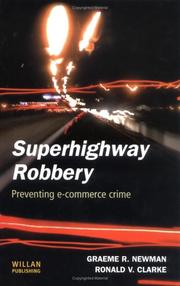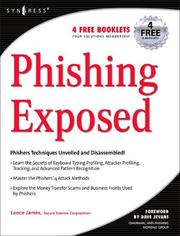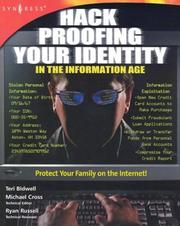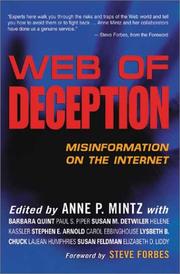| Listing 1 - 9 of 9 |
Sort by
|

ISBN: 1843920182 Year: 2002 Publisher: Cullompton Willan
Abstract | Keywords | Export | Availability | Bookmark
 Loading...
Loading...Choose an application
- Reference Manager
- EndNote
- RefWorks (Direct export to RefWorks)
This book analyzes the expanding crime opportunities created by the Internet and e-commerce, and it explains how concepts of crime prevention developed in other contexts can be effectively applied in this new environment. The authors note that the Internet and associated e-commerce constitute a lawless "wild frontier" where users of the Internet can anonymously exploit and victimize other users without a high risk of being detected, arrested, prosecuted, and punished. For acquisitive criminals who seek to gain money by stealing it from others, e-commerce through the Internet enables them to "hack" their way into bank records and transfer funds for their own enrichment. Computer programs that are readily available for download on the Web can be used to scan the Web for individual computers that are vulnerable to attack. By using the Internet addresses of other users or using another person's or organization's computers or computing environment, criminals can hide their trails and escape detection. After identifying the multiple opportunities for crime in the world of e-commerce, the book describes specific steps that can be taken to prevent e-commerce crime at particular points of vulnerability. The authors explain how two aspects of situational crime prevention can prevent Internet crime. This involves both a targeting of individual vulnerabilities and a broad approach that requires partnerships in producing changes and modifications that can reduce or eliminate criminal opportunities. The authors apply the 16 techniques of situational crime prevention to the points of vulnerability of the e-commerce system. The points of vulnerability are identified and preventive measures are proposed. In discussing the broad approach of institutionalized and systemic efforts to police e-commerce, the book focuses on ways to increase the risks of detection and sanctions for crime without undue intrusions on the freedom and privacy of legitimate Internet and e-commerce users.
Internet fraud --- Computer crimes --- Prevention. --- Prevention --- Fraud
Book
ISBN: 0128029463 0128029277 1322480850 9781322480855 9780128029466 9780128029275 Year: 2014 Publisher: Amsterdam Elsevier
Abstract | Keywords | Export | Availability | Bookmark
 Loading...
Loading...Choose an application
- Reference Manager
- EndNote
- RefWorks (Direct export to RefWorks)
Phishing is one of the most widely-perpetrated forms of cyber attack, used to gather sensitive information such as credit card numbers, bank account numbers, and user logins and passwords, as well as other information entered via a web site. The authors of A Machine-Learning Approach to Phishing Detetion and Defense have conducted research to demonstrate how a machine learning algorithm can be used as an effective and efficient tool in detecting phishing websites and designating them as information security threats. This methodology can prove useful to a wide variety of businesses and organiza
Phishing. --- Computer networks --- Security measures. --- Computer network security --- Network security, Computer --- Security of computer networks --- Computer security --- Brand spoofing (Internet fraud) --- Carding (Internet fraud) --- Spoofing, Brand (Internet fraud) --- Identity theft --- Internet fraud
Book
ISBN: 9781843925231 1843925230 9781843925248 1843925249 9786612462740 1134030592 1282462741 1843929333 9781843929338 9781134030590 9781134030668 9781134030736 Year: 2009 Publisher: Cullompton : Willan,
Abstract | Keywords | Export | Availability | Bookmark
 Loading...
Loading...Choose an application
- Reference Manager
- EndNote
- RefWorks (Direct export to RefWorks)
An essential reference for scholars and others whose work brings them into contact with managing, policing and regulating online behaviour, the Handbook of Internet Crime emerges at a time of rapid social and technological change. Amidst much debate about the dangers presented by the Internet and intensive negotiation over its legitimate uses and regulation, this is the most comprehensive and ambitious book on cybercrime to date. The Handbook of Internet Crime gathers together the leading scholars in the field to explore issues and debates surrounding internet-relat
Computerkriminalität. --- Computer crimes --- Computer crimes. --- Internet. --- Internet fraud. --- Criminalité informatique --- Criminologie --- Cybercriminalité. --- Crimes et criminels --- Cybercriminalité.

ISBN: 9781597490306 1423754301 9781423754305 159749030X 0080489532 9780080489537 9781597499958 1597499951 1281035874 9781281035875 9786611035877 1299730426 0124047238 Year: 2005 Publisher: Rockland, MA Syngress
Abstract | Keywords | Export | Availability | Bookmark
 Loading...
Loading...Choose an application
- Reference Manager
- EndNote
- RefWorks (Direct export to RefWorks)
Phishing Exposed unveils the techniques phishers employ that enable them to successfully commit fraudulent acts against the global financial industry. Also highlights the motivation, psychology and legal aspects encircling this deceptive art of exploitation. The External Threat Assessment Team will outline innovative forensic techniques employed in order to unveil the identities of these organized individuals, and does not hesitate to remain candid about the legal complications that make prevention and apprehension so difficult today. This title provides an in-depth, high-tech
Identity theft. --- Internet fraud. --- Phishing. --- Brand spoofing (Internet fraud) --- Carding (Internet fraud) --- Spoofing, Brand (Internet fraud) --- Identity theft --- Internet fraud --- Computer crimes --- Fraud --- Identity fraud --- False personation --- Theft --- Information Technology --- General and Others --- Computer security --- Electronic government information --- Information technology --- Risk management --- Government policy --- Security measures --- Management. --- Insurance --- Management --- IT (Information technology) --- Technology --- Telematics --- Information superhighway --- Knowledge management --- Electronic government publications --- Government information --- Government publications --- Computer network resources
Book
ISBN: 9781484277447 Year: 2022 Publisher: Berkeley, CA Apress :Imprint: Apress
Abstract | Keywords | Export | Availability | Bookmark
 Loading...
Loading...Choose an application
- Reference Manager
- EndNote
- RefWorks (Direct export to RefWorks)
Mitigate the dangers posed by phishing activities, a common cybercrime carried out through email attacks. This book details tools and techniques to protect against phishing in various communication channels. The aim of phishing is to fraudulently obtain sensitive credentials such as passwords, usernames, or social security numbers by impersonating a trustworthy entity in a digital communication. Phishing attacks have increased exponentially in recent years, and target all categories of web users, leading to huge financial losses to consumers and businesses. According to Verizon's 2020 Data Breach Investigations Report (DBIR), 22% of all breaches in 2019 involved phishing. And 65% of organizations in the USA experience a successful phishing attack. This book discusses the various forms of phishing attacks, the communications most often used to carry out attacks, the devices used in the attacks, and the methods used to protect individuals and organizations from phishing attacks. What You Will Learn Understand various forms of phishing attacks, including deceptive, DNS-based, search engine, and contents injection phishing Know which communications are most commonly used, including email, SMS, voice, blog, wifi, and more Be familiar with phishing kits (what they are) and how security experts utilize them to improve user awareness Be aware of the techniques that attackers most commonly use to request information Master the best solutions (including educational, legal, technical) to protect against phishing attacks Who This Book Is For Security professionals who need to educate online users, especially those who deal with banks, online stores, payment systems, governments organizations, social networks and blogs, IT companies, telecommunications companies, and others. The secondary audience includes researchers working to develop novel strategies to fight against phishing activities and undergraduate and graduate instructors of cybersecurity.
Computer crimes. --- Computer security. --- Data protection. --- Data governance --- Data regulation --- Personal data protection --- Protection, Data --- Electronic data processing --- Computer privacy --- Computer system security --- Computer systems --- Computers --- Cyber security --- Cybersecurity --- Electronic digital computers --- Protection of computer systems --- Security of computer systems --- Data protection --- Security systems --- Hacking --- Computers and crime --- Cyber crimes --- Cybercrimes --- Electronic crimes (Computer crimes) --- Internet crimes --- Crime --- Privacy, Right of --- Protection --- Security measures --- Phishing --- Prevention. --- Brand spoofing (Internet fraud) --- Carding (Internet fraud) --- Spoofing, Brand (Internet fraud) --- Identity theft --- Internet fraud
Book
ISBN: 1282189719 9786612189715 1443803030 9781443803038 1443801089 9781443801089 9781282189713 6612189711 Year: 2009 Publisher: Newcastle upon Tyne : Cambridge Scholars Pub.,
Abstract | Keywords | Export | Availability | Bookmark
 Loading...
Loading...Choose an application
- Reference Manager
- EndNote
- RefWorks (Direct export to RefWorks)
The Internet is nothing less than a medium for the indiscriminate and global dissemination of information if we take ""information"" in its cybernetic sense as bits of data - any data. As such, it is also a massive, amorphous, rhizomic collection of substantiated facts, guesswork, fantasy, madness, debate, criminal energy, big business, stupidity, brilliance, all in all a seemingly limitless multiplication of voices, all clamouring to be heard. It is a medium which proliferates stories, narrat...
Literature and the Internet. --- Internet fraud. --- Internet --- Fan fiction --- Fan fic --- Fanfic --- Fiction --- Computer crimes --- Fraud --- Internet and literature --- Social aspects. --- History and criticism.
Book
ISBN: 9780910965910 0910965919 Year: 2012 Publisher: Medford, N.J. : CyberAge Books,
Abstract | Keywords | Export | Availability | Bookmark
 Loading...
Loading...Choose an application
- Reference Manager
- EndNote
- RefWorks (Direct export to RefWorks)
Skilled researchers, journalists, and subject experts have come together in this follow-up to Web of Deception to reveal important lessons for staying safe and retaining privacy online. In the wake of the social media popularity boom-epitomized by MySpace, eBay, and Craigslist and accelerating with Facebook and Twitter-the success of internet con artists and thieves has been quick to follow. Manipulators have been provided with the tools and targets to perpetrate hoaxes and con games on an ever larger scale. An invaluable guide to safe internet usage, this resource explains the importance of guarding privacy and identity online, spotting misinformation, avoiding charity scams, and evaluating websites.
Internet fraud. --- Electronic information resource literacy --- Computer network resources --- Internet searching. --- Information literacy --- Disinformation. --- Fraude sur Internet --- Connaissances des sources d'information électroniques --- Information électronique --- Recherche sur Internet --- Culture de l'information --- Désinformation --- Evaluation. --- Evaluation

ISBN: 1281055999 9786611055998 0080478085 1931836515 1932266259 9781932266252 9780080478081 9781931836517 Year: 2002 Publisher: Rockland, MA Syngress
Abstract | Keywords | Export | Availability | Bookmark
 Loading...
Loading...Choose an application
- Reference Manager
- EndNote
- RefWorks (Direct export to RefWorks)
Identity-theft is the fastest growing crime in America, affecting approximately 900,000 new victims each year. Protect your assets and personal information online with this comprehensive guide.Hack Proofing Your Identity will provide readers with hands-on instruction for how to secure their personal information on multiple devices. It will include simple measures as well as advanced techniques gleaned from experts in the field who have years of experience with identity theft and fraud. This book will also provide readers with instruction for identifying cyber-crime and the different
Computer security. --- Identification cards --- Internet fraud. --- Computer crimes. --- Impostors and imposture. --- Forgeries. --- Computers and crime --- Cyber crimes --- Cybercrimes --- Electronic crimes (Computer crimes) --- Internet crimes --- Charlatans --- Imposters --- Pretenders --- Fake identification cards --- Forged identification cards --- Forgery of identification cards --- Phony identification cards --- Computer privacy --- Computer system security --- Computer systems --- Computers --- Cyber security --- Cybersecurity --- Electronic digital computers --- Security of computer systems --- Security measures --- Protection of computer systems --- Protection --- Crime --- Privacy, Right of --- Computer crimes --- Fraud --- Criminals --- Data protection --- Security systems --- Hacking

ISBN: 0910965609 Year: 2002 Publisher: Medford (N.J.) Information Today
Abstract | Keywords | Export | Availability | Bookmark
 Loading...
Loading...Choose an application
- Reference Manager
- EndNote
- RefWorks (Direct export to RefWorks)
Internet --- Miscommunicatie --- Informatiemaatschappij --- Websites --- Kwaliteit --- Evaluatie --- Computer network resources --- Electronic information resource literacy --- Internet fraud --- Internet searching --- 001.95 --- 025.4.036 --- 691 Internet --- #A0308A --- 001.95 Wetenschappelijk bedrog en mystificatie --- Wetenschappelijk bedrog en mystificatie --- 025.4.036 Computer aided search. Online searching. Zoeken op internet --- 025.4.036 Machinale zoekmethodes. Zoeken met behulp van computers --- Computer aided search. Online searching. Zoeken op internet --- Machinale zoekmethodes. Zoeken met behulp van computers --- Searching the Internet --- Web searching --- World Wide Web searching --- Electronic information resource searching --- Computer crimes --- Fraud --- Information literacy --- Internet resources --- Remote access electronic resources --- Remote electronic resources --- Resources, Computer network --- Electronic information resources --- Uniform Resource Identifiers --- Evaluation --- Website --- Kwaliteit (proceskenmerk)
| Listing 1 - 9 of 9 |
Sort by
|

 Search
Search Feedback
Feedback About UniCat
About UniCat  Help
Help News
News